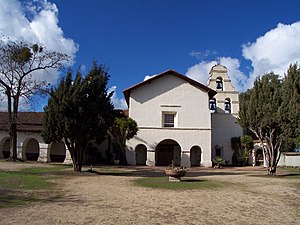Mission San Juan Bautista

A view of the restored Mission San Juan Bautista and its added three-bell campanario ("bell wall") in 2010. Two of the bells were salvaged by Father Nick Senf in 2009 from the original chime, which was destroyed in the 1906 San Francisco earthquake.
|
|
|
Location of Mission San Juan Bautista in California
|
|
| Location | 406 2nd Street San Juan Bautista, California 95045 |
|---|---|
| Coordinates | 36°50′42″N 121°32′09″W / 36.845083°N 121.535889°WCoordinates: 36°50′42″N 121°32′09″W / 36.845083°N 121.535889°W |
| Name as founded | La Misión del Glorios Precursor de Jesu Cristo, Nuestro Señor San Juan Bautista |
| English translation | The Mission of the Glorious Precursor of Jesus Christ, Our Lord, Saint John the Baptist |
| Patron | Saint John the Baptist |
| Nickname(s) | "Mission of Music" |
| Founding date | June 24, 1797 |
| Founding priest(s) | Father Fermín Lasuén |
| Founding Order | Fifteenth |
| Military district | Third |
|
Native tribe(s) Spanish name(s) |
Mutsun, Yokuts Costeño |
| Native place name(s) | Popeloutchom |
| Baptisms | 4,106 |
| Marriages | 1,003 |
| Burials | 2,854 |
| Secularized | 1835 |
| Returned to the Church | 1859 |
| Governing body | Roman Catholic Diocese of Monterey |
| Current use | Parish Church |
| Reference no. |
|
| Website | |
| http://www.oldmissionsjb.org/ | |
Mission San Juan Bautista is a Spanish mission in San Juan Bautista, San Benito County, California. Founded on June 24, 1797 by Fermín Lasuén of the Franciscan order, the mission was the fifteenth of the Spanish missions established in present-day California. Named for Saint John the Baptist, the mission is the namesake of the city of San Juan Bautista.
Barracks for the soldiers, a nunnery, the Jose Castro House, and other buildings were constructed around a large grassy plaza in front of the church and can be seen today in their original form. The Ohlone, the original residents of the valley, were brought to live at the mission and baptized, followed by Yokuts from the Central Valley. Mission San Juan Bautista has served mass daily since 1797, and today functions as a parish church of the Diocese of Monterey.
Following its creation in 1797, San Juan's population grew quickly. By 1803, there were 1,036 Native Americans living at the mission. Ranching and farming activity had moved apace, with 1,036 cattle, 4,600 sheep, 22 swine, 540 horses and 8 mules counted that year. At the same time, the harvest of wheat, barley and corn was estimated at 2,018 fanegas, each of about 220 pounds.
Father Pedro Estévan Tápis (who had a special talent for music) joined Father Felipe Arroyo de la Cuesta, at Mission San Juan Bautista in 1815 to teach singing to the Indians. He employed a system of notation developed in Spain that uses varied colors or textures for polyphonic music, usually (from bottom to top) solid black, solid red, black outline (sometimes solid yellow) and red outline (or black outline when yellow was used). His choir of Native American boys performed for many visitors, earning the San Juan Bautista Mission the nickname "the Mission of Music." Two of his handwritten choir books are preserved at the San Juan Bautista Museum. When Father Tapis died in 1825 he was buried on the mission grounds. The town of San Juan Bautista, which grew up around the mission, expanded rapidly during the California Gold Rush and continues to be a thriving community today.
...
Wikipedia

